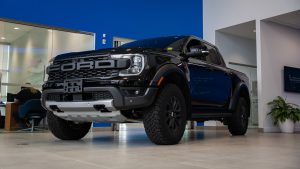When shopping for a vehicle, one of the most important features to consider is the drivetrain. The drivetrain determines how power is delivered from your engine to your wheels, and it can have a big impact on your vehicle’s handling, performance, fuel efficiency, and capability in different driving conditions.
At Birchwood, we want to help you find the drivetrain that fits your lifestyle. Here’s a breakdown of the most common types and what you need to know before you buy.
All-Wheel Drive (AWD)
AWD systems automatically send power to all four wheels, either all the time or only when needed, without input from the driver. This gives consistent traction in varying conditions.
Pros:
- Great for varying road conditions, such as rain, snow, and gravel
- No need to switch modes, AWD works automatically to adjust traction
Cons:
- Typically more expensive than 2-Wheel Drive (2WD) systems
- Slightly lower fuel efficiency due to the added weight and complexity
Best for:
Drivers who deal with unpredictable weather, like Manitoba winters, and want year-round confidence without having to think about switching modes.
Four-Wheel Drive (4WD or 4x4)
4WD systems are often driver-controlled and are designed for off-road use. You can manually turn on 4WD to send power to all four wheels when extra traction is needed.
Pros:
- Excellent off-road capability and power in rugged terrain
- Strong performance in deep snow, mud, or sand
Cons:
- Heavier and more complex than other systems, which can affect fuel economy
- Not always ideal for everyday driving on dry pavement
Best for:
Drivers who frequently go off-road, live in rural areas, or need extra traction for outdoor activities like camping or hauling trailers.
Front-Wheel Drive (FWD, 2WD)
FWD vehicles send power to the front wheels only. This is the most common drivetrain for cars and smaller SUVs.
Pros:
- More fuel-efficient and lightweight compared to AWD or 4WD
- Better traction in slippery conditions compared to RWD, since the engine’s weight is over the drive wheels
Cons:
- Less dynamic handling compared to RWD
- Can struggle with steep hills or heavy snow compared to AWD or 4WD
Best for:
City drivers and commuters looking for a reliable, cost-effective option with decent traction in mild to moderate winter conditions.
Rear-Wheel Drive (RWD, 2WD)
RWD vehicles deliver power to the rear wheels, which pushes the vehicle forward. This layout is common in performance cars, trucks, and some SUVs.
Pros:
- Balanced weight distribution offers better handling and acceleration
- Often used in performance vehicles for a more engaging driving experience
Cons:
- Can be challenging in slippery conditions, like snow or ice.
- Less common in passenger vehicles outside of trucks and sports cars.
Best for:
Drivers focused on performance or towing, or those who don’t typically face harsh winter conditions.
How Birchwood Helps You Choose the Right Drivetrain
Whether you’re a daily commuter, weekend adventurer, or navigating snow-covered streets in winter, Birchwood offers a wide selection of vehicles with all types of drivetrains. Our Product Advisors will ask about your driving habits, location, and needs to help match you with the best option. We also offer test drives, financing, and vehicle education so you can feel confident in your decision!
Visit a Birchwood dealership or browse our online inventory to explore your options. We’ll help you find the perfect fit for your lifestyle and driving needs.


